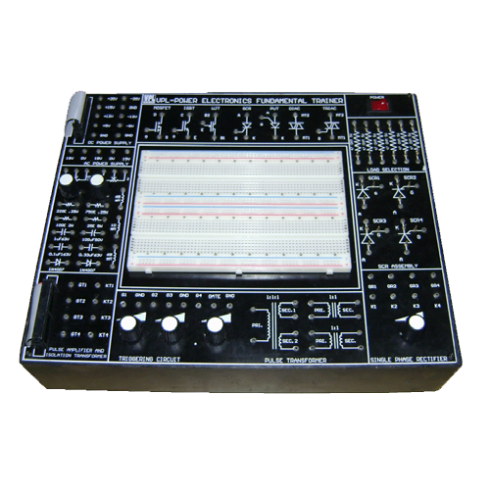Power Electronics Fundamentals Trainer (VPL-PEL-LAB)
VPL Power Electronics Lab is used to perform all the power electronics circuit experiments. It is very useful in power electronics laboratory for performing different experiments. It helps the student to know about the characteristics of power electronics devices and their applications. The applications of power devices are in alarm circuit, lamp flasher, rectifiers, choppers, inverters, etc. The trainer consists of different functional blocks marked clearly for easy understanding.
SPECIFICATIONS
- Size of Breadboard: 172.5 mm 128.5mm
- AC Power Supply on Board: 18V-0V-18V, 0V-15V
- DC Power Supply on board: +5 V, -5 V 500 mA, +12V, -12 V 500 mA, +15 V, 250 mA, +35V, -35V, 250 mA
- Triggering Circuit on Board : 5 gate signal output. PWM control of G1, G2, G3 and G4 Duty cycle control of “Gate” Signal is 0 to 100%
- Single Phase Rectifier: Firing angle control 0 º-180 º variables
- Firing Circuit on Board: Four gate signal output with isolation.
- SCR Assembly: 4 SCRs 2P4M, 600V, 2A
- Power Devices: IGBT-G4BC20S, MOSFET-IRF Z44N, SCR TYN 616, UJT-2N2646, DIAC-DB3, TRIAC-BT136, PUT- 2N6027
- Accessories : Patch cords, breadboards, power cord, operating manual
This trainer can also be used to study the following :-
- Study of the V-I characteristics of IGBT
- Study of the V-I characteristics of MOSFET
- Study of the V-I characteristics of SCR
- Study of the V-I characteristics of UJT
- Study of the V-I characteristics of DIAC
- Study of the V-I characteristics of TRIAC
- Study of the V-I characteristics of PUT
- Study of R triggering circuit
- Study of the half wave controlled rectifier with R load
- Study of the fully controlled Bridge rectifier with R load.
OTHER POWER ELECTRONICS TRAINER KITS
- AC Phase Control Circuit (PET-ACP)
- Power Electronics Trainer/Basic Electronics Trainer (DL-BET)
- Study of 3 Phase Half wave/Full wave Controller Rectifier (PETFHCR)
- Jones Chopper Circuit (PET-JCC)
- Series Inverter (PET-SI)
- Parallel Inverter (PET-PI)
- Speed Control of 3-Phase Induction Motor (PET-TPIM)
- R-RC Triggering Circuit (PET-RRC)
- Commutation Circuit Trainer (PET-CCT)
- Rectifier Trainer (PET-RTK)
- SCR Characteristics (PET-SCR)
- DIAC Characteristics (PET-DIAC)
- TRIAC Characteristics (PET-TRIAC)
- SCR/TRIAC/DIAC characteristics (3 in 1) Trainer (PET-SCR/ DIAC/TRIAC)
- FET Characteristics (PET-FET)
- MOSFET Characteristics (PET-MOSFET)
- UJT Characteristics & UJT Firing (PET-UJT)
- Speed Control of DC Motor (Open Loop) (PET-SCDC-OL)
- Speed Control of DC Motor (Close Loop) (PET-SCDC-CL)
- Power Electronics Fundamentals Trainer (VPL-PEL-LAB)
- Power Electronics Control Unit (VPL-PEL-CU)
- Power & Industrial Electronics Trainer (VPL-PIET)
- Trainer for Power Electronics Components Characteristics
- Trainer for UJT & PUT Firing Circuit
- Trainer for PUT Experiments
- Trainer for TRIAC Overflow Experiments
- Trainer for SCS, Temperature Ratio & Touch Control Experiments
- Trainer for AC/DC Motor Control using SCR
- Trainer for various Turn ON Techniques for SCR
- Trainer for Speed Control Experiments
- Trainer for Over Voltage Under Voltage Breaker and Flasher Control Experiments
- Trainer for IC Timer Switch Experiments using IC 555
- Trainer for SCR Commutation Techniques
- Trainer for Digital Signal Driver, Zero Voltage Switch Advance Firing Scheme Experiments
- Trainer for SCR Inverter Experiments
- Trainer for SCR Converter Experiments (Half wave)
- Trainer for SCR Converter Experiments (Full wave)
- Trainer for SCR based Choppers
- Trainer for IGBT/MOSFET Inverter Experiments
- Trainer for Mc Murray Half Bridge Inverter
- Trainer for Jones Chopper Experiments
- Trainer for Three Phase Fully Controlled Converter
- Trainer for Three Phase Half Controlled Converter
- Trainer for Series Inverter Experiments
- Trainer for Cyclo Converter Experiments
Note: Specifications can be changed, added or subtracted without notice in our constant efforts for improvement.

